×
[PR]上記の広告は3ヶ月以上新規記事投稿のないブログに表示されています。新しい記事を書く事で広告が消えます。
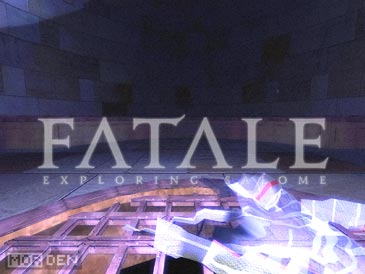
There have always been two kinds of computer generated content that were meant to entertain: games and mostly non interactive demos. In the first category we get all the commercial and indie productions where it's all about the plot or skill. In the second category, we have the vast world of computer scene, which, for the most part, offers us non-interactive audiovisual demonstrations that aim to either entertain or impress, by pushing the hardware boundaries.
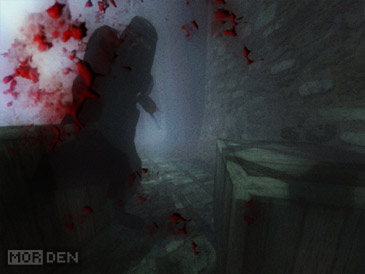
There has been, however, very little content that would fit in between all the games and scene demos. Lately, Tale of Tales have been hard at work, trying to bridge this gap. Their philosophy is simple - art comes first, interactivity, plot and accessibility comes second. This approach resulted in several off-beat titles being made, one of which, The Graveyard, I have already written about. Tale of Tales' newest, for the lack of a better description, interactive experience is called Fatale: Exploring Salome.

Fatale is not a game in the usual sense of the word, but, simply because it feels wrong to call it an interactive experience over and over again, I'll allow myself to call it just that - a game. The story presented in Fatale is based on Oscar Wilde's Salome but if you're hoping to play a plot driven adventure featuring the daughter of Herodias and tons of drama, you will be disappointed. This time, you'll be controlling the actions of John the Baptist, briefly.
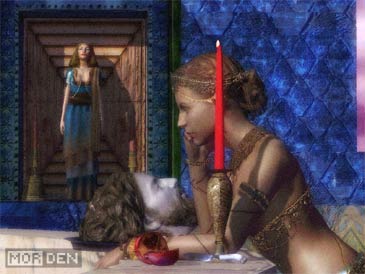
The game does not waste any time on explaining the Salome story to the player, so unless you know it already, you'll have to educate yourself on the subject. But, since I'm a nice guy and you're already here, reading this, I might just as well spare you the trouble of looking it up. Long story short - Salome is a biblical character, featured in the gospels of the New Testament. On the day of her stepfather's, Herod Antipas', birthday, she performed a dance, as a reward for which, she would get one of her wishes granted. Influenced by her mother, Herodias, Salome requested John the Baptist to be beheaded. This was Herodias' revenge on John, for calling her marriage to Herod unlawful.
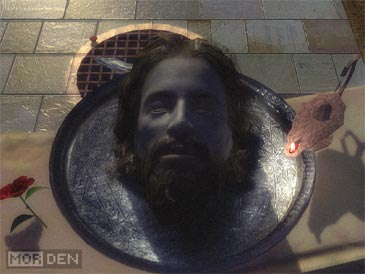
That's the original story. Oscar Wilde's version has Salome taking an interest in John the Baptist, called Jokanaan in the play, but being rejected by him and called daughter of Sodom. Here, it is the rejection that is the reason behind Jokanaan's execution. In both versions however, the cut off head is placed on a silver platter that's given to Salome. As you can see, starting the game as John the Baptist eliminates any possibility of a happy end. Especially since the very first scene is taking place in a dungeon, atop of which Salome is dancing the dance of seven veils, after which she will get her wish granted.

We do lose our head very early in the game, but after that we get to roam freely around and above the terrace build upon the place of our execution. Time seems to be frozen and we find Salome looking into empty space with the severed head on a platter beside her. This scene is the main part of the experience. We explore the terrace while stealing the flames from the candles. We find the seven veils scattered all over the place and even though we do not have a physical form, we can affect some objects by creating really gentle gusts of wind which allow us to move the veils around.
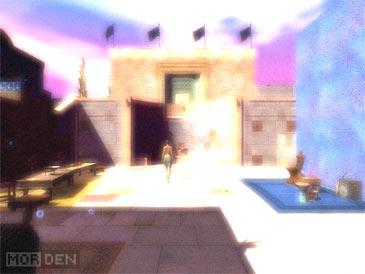
Once we steal all the flames, the night turns into day and the game ends, or so it would seem. When we start it again, we'll witness Salome's dance viewed from Herod's perspective. The girl will be working hard to keep us entertained, and all we can do is zoom in and admire her beauty for brief moments, before the flashes showing parts of her body will cause the camera to zoom out again. When Salome is done, the show really is over and we can start again, from scratch.
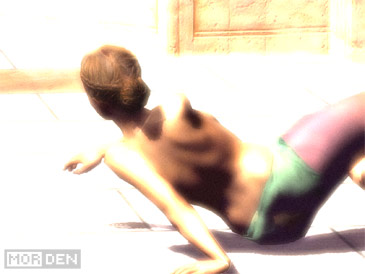
All this writing and I didn't even mention the music. A huge mistake, since the music and sound are a very important part of the Fatale experience. When imprisoned at the very beginning, we'll hear the music playing. The music that accompanies Salome's dance. Once it reaches its climax, our head comes off. When we explore the terrace and steal the flames, we hear all sorts of whispers, which create an unforgettable atmosphere. During the last sequence when Salome dances in front of Herod, we get to hear the same music as the one we heard at the beginning, only this time we hear it clearly.
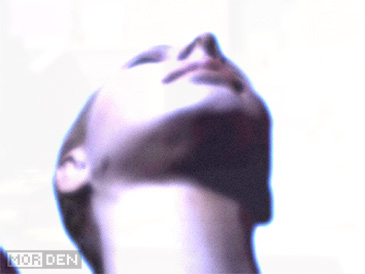
Is Fatale worth the $7 Tale of Tales is asking for it? I'd say it is. It's less play than The Path, but so much more than The Graveyard, and we don't have to pay extra just to see the severed head. There are very few characters in the game, but those you'll see look brilliant, which isn't a surprise really, since they were designed by Takayoshi Sato of Silent Hill fame. Tale of Tales did a great job of putting this incredible experience together. It's definitely not for everyone, but those who are curious and don't have high hopes for hours of gameplay might get a pleasant surprise. After finishing Fatale I'm still curious about one thing, though. Throughout the terrace scene there are several modern age objects placed here and there. You can spot a guitar with an amplifier, a match-book with "Salome - Call me" written on it and an iPod on Salome herself. What's that about, Tale of Tales?
PR
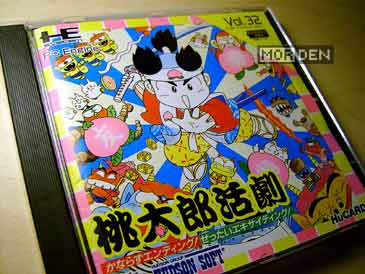
It was about time to dust off the PC Engine, which I've been neglecting for the past year, or maybe two. I felt like playing a decent platformer - one that I haven't beaten yet. After all, how gratifying can another completion of Super Mario Brothers be? I browsed through my games and remembered, that one of Hudson's Momotarō titles is in fact a platformer - the rest of them are RPGs, which I never really started.
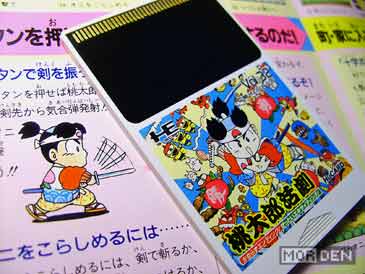
Before I tell you more about the game, let's focus on the Momotarō character for a second, as he's a very popular Japanese folk tale hero who deserves to have his story told. As the legend has it, one day a giant peach floated down the river and was found by a woman who, when trying to eat the enormous fruit along with her husband, discovered the child hidden inside. Having no children of their own, the couple adopted the little boy and named him Momotarō, "momo" meaning peach and "tarō" the first-born son.
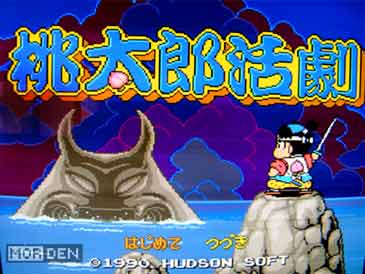
For years Momotarō lived with his adoptive parents, but one day he embarked on a journey to the island of Onigashima, which translated to "an island of demons", to fight all the evil beings found there. During his journey, Momotarō met three animals who joined and aided him in his quest - A dog, a monkey and a pheasant. The demon extermination went smoothly and from then on everyone lived happily ever after. This classic story, or parts of it, made it into a lot of games, manga and anime. If you ever come across a story in which a hero is accompanied by three pets, you can be sure it's either entirely or loosely based on the Momotarō tale.
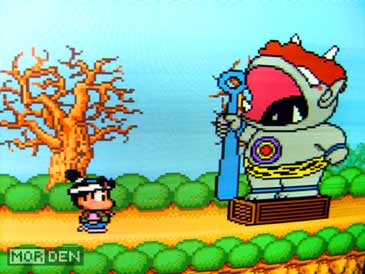
So, how does the game compare to the legend? For obvious reasons, the story skips ahead to the day when Momotarō leaves his home village and decides he wants to be a demon slayer. Already in the introduction we get to see all three animals which we will most likely save. The only thing that seemed weird to me is the fact that the dog looks like a cat. This might just be me, but pointy teeth and whiskers scream cat, not dog. Oh well, I can only hope that some in-game cut scene will explain this irregularity.
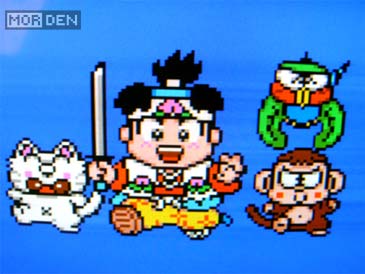
The game itself is a blast to play. The soundtrack is just awesome and the graphics are very colourful and detailed for their time. PC Engine is well known for being able to handle really large sprites, which was proven beyond any doubt by PC-Genjin 3, also known as Bonk 3: Bonk's Big Adventure. Momotarō Katsugeki features some nice boss fights that despite looking good, will put your patience to the test, so be warned. The game is most certainly worth getting, along with the rest of Momotarō titles released by Hudson.
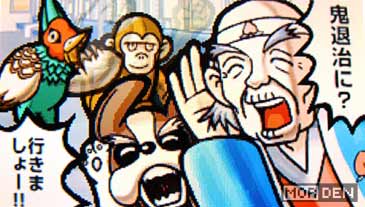
Since we're already on the Momotarō subject, I figured I should metion his appearance in iNiS' Moero! Nekketsu Rhythm Damashii: Osu! Tatakae! Ouendan 2. The story was adapted to fit the humour of the game, so this time we meet an elderly Momotarō Okayama, named after the prefecture from which peach-boy legend originated, who comes by the Department of Pension office to pick up his cheque. The lady clerk informs him that he is required to fight the Onigashima demons once again and so, joining up with the usual team of pets, the elderly hero does it again, aided by the enthusiastic male cheerleaders.

In totally unrelated news, on November 2nd Tale of Tales was giving away free copies of The Graveyard to celebrate the All Souls’ Day. When i wrote about The Graveyard, I said I wasn't planning on paying $5 just to see an old lady die, so imagine my surprise when I got to see her die for free. A nice gesture on Tale of Tales' part, even though they shouldn't have charged the $5 in the first place. They're cool people though, so support them if you can and buy their games, because they're awesome.
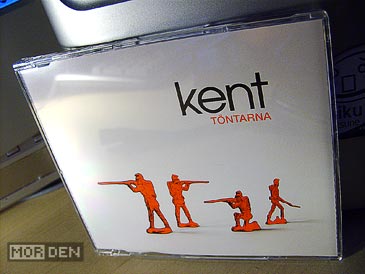
It's been two years since Kent's last studio album Tillbaka Till Samtiden, and yesterday, their new single Töntarna from the upcoming album Röd had its retail premiere, roughly a week after the digital release. I finally got my copy, a day late, because my local music store couldn't be bothered with packing up the boxes the day they have arrived. Running a music store these days can't be easy, and I'm sure that this kind of attitude will lose them customers in favour of on-line retailers who, surprisingly, deliver on time.

For those who don't know, Kent is a Swedish indie and alternative rock band, whose music I am a huge fan of. They've been active since 1990, and during the last couple of years, they've been drifting more and more towards a sound that I could only describe as a modern take on the '80s synthpop. The noticeable change of style however, did not affect the quality of Kent's releases - on the contrary, based on taste, one could argue that the quality is constantly improving, and that's exactly what kept me a faithful fan of the group.
Töntarna, which translates to "dorks" by the way, is a three track single, featuring the title song and two remixes - one by a British DJ duo Punks Jump Up, who have plenty of mix tracks on their list of achievements, and another by Familjen, a one man electronica act from Sweden. This is the second time when Punks Jump Up remix Kent, first one being their version of Vy Från Ett Luftslott from Tillbaka Till Samtiden, and I have to say that their take on the song comes out on top. If you want to listen to the remixes, look up MySpace pages of the respective mixers and knock yourself out. Above is the original song, so before you go on a remix hunt, I suggest you listen to it first.
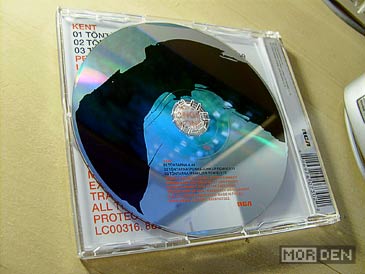
The full album Röd will be released sometime next month and will be available in two versions. One will be a regular CD and the other an exclusive box containing the cd album with an alternative cover, three ten inch LPs, a USB memory stick loaded with mp3 files and a 120 page book. Sounds like a proper collector's edition and I'll most definitely get it, but it will set me back $94. Oh well, at least I won't be buying a separate vinyl this time around.

Another bunch of console related items arrived this monday, missing the weekend, because I would have enjoyed it too much if the package arrived on friday. Oh well, no point in complaining now, since the stuff is here to stay. Since you always should protect your handheld consoles, especially their sensitive screens, I got myself some new screen protectors for Nintendo DS Lite and PSP 2000, and a crystal case for the DS. Because accessories that keep your console safe from harm aren't too exciting, I also got a EZ Flash V 3 in 1 espansion cartridge, but I'll get to that in a minute.
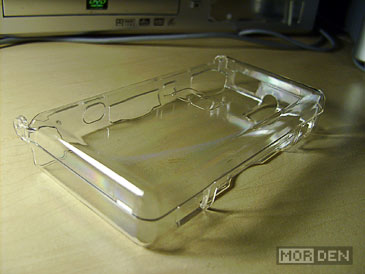
I'm not a huge fan of external covers for handhelds. I always keep my consoles in cases designed to protect the hardware when I'm not using it. What ultimately convinced me of getting the crystal case for my DS Lite, was the console's smooth surface combined with its black color, which made it into a fingerprinting machine. I am a clean person and I always wash my hands before I play, but it's simply impossible not to leave fingerprints all over the DS Lite. The constant wiping and cleaning may eventually lead to some scratches, and I would much rather wipe the crystal cover than the DS itself.

I wasn't expecting much when I ordered this, as it was a $2 product, but I was pleasantly surprised once I put the cover on my DS. It firs perfectly and the console itself is only slightly bigger. I was afraid it would feel awkward to hold it, but it doesn't. The only thing I did react to was the access to shoulder buttons. The case doesn't cover them in any way, but the fingers can no longer rest in the same way I was used to. It is however only a matter of adjustment. After a few games I didn't really think about it. Changing the volume will feel different as well, but because of the cover you will no longer change the volume accidentally, which did happen to me many, many times.
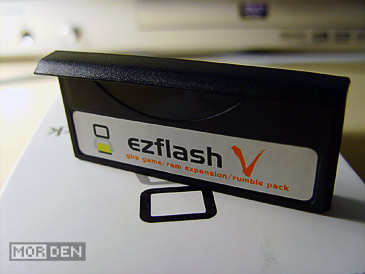
Now, how about that EZ Flash V 3 in 1? I have never really thought about getting one of these, but since many homebrew applications use or even require additional RAM - which I didn't have up until now, because I thought it was pointless to buy a Nintendo DS browser just to get it, and other alternatives seemed a bit expensive - and there are some games that utilize the rumble feature, I thought why not? The price-tag was just under $19 including shipping, and if I didn't get it now, I probably never would. So I ordered it, excited about the new possibilities and some positive vibrations.
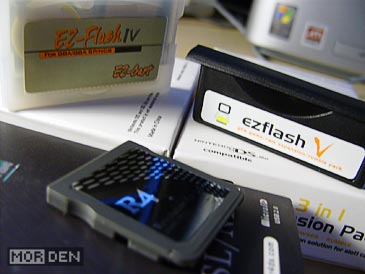
The first thing I noticed when I took it out of its box was the build quality. It leaves much to be desired and getting it in the first time was a problem. For a second I thought it wouldn't fit the slot, but as it turns out, you have to insert it at a slight angle. Once the cartridge was in, I popped Metroid Prime Hunters into slot one and got ready for the vibrations. No such luck. The game didn't see it. Apparently, I didn't research it well enough, and the rumble feature is available, but only through certain flash cart firmwares or special loaders, which in its turn means that the feature caters to those who use ROM images rather than original games. Supposedly there is a way to make it work with originals, but I haven't had the time to look into it.
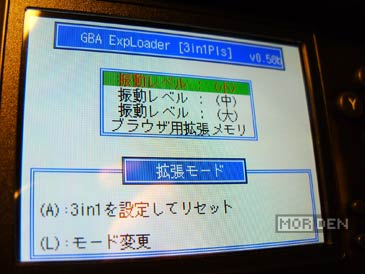
Since the vibrations didn't work as I thought, I wanted to check what does work. After trying several things I realized that EZ Flash V 3 in 1 is anything but user friendly. In fact, getting it to work seemed like a chore at first, before I read a bunch of documents and downloaded appropriate software. Just to clarify what the three functions of this cartridge are: It is a RAM expansion, a Rumble Pak and a Game Boy Advance flash unit featuring both PSRAM and NOR memory, with the NOR being able to hold only one program at a time. Only after getting Rudolph's GBA ExpLoader I could really test the cartridge. Since the GBA NOR memory can hold only one program, I loaded Gleam, an excellent freeware Lumines clone onto it and that's probably what I'm going to use the GBA feature for the most. It's important to note that EZ Flash V 3 in 1, in conjunction with a slot one flash device, is capable of backing up and restoring original Nintendo DS game save data, as well as backing up whole Nintendo DS games.
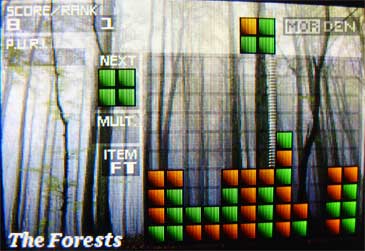
After the initial failure to get the rumble feature working, I tested the ram expansion, which doesn't require additional programs to run, but the homebrew software has to be compatible with this particular expansion model. Not too long ago, a ScummVM porter named Agentq released a special ScummVM DS build capable of running SCUMM Ver. 7 games, Full Throttle and The Dig, utilizing RAM expansion. This was the first homebrew application I tested the extended RAM function with, so I had my fingers crossed when booting it, but it worked. So far I have only tested Full Throttle, which I recently completed on PSP. Sadly, the save games weren't compatible, so to see if the game really works, I will have to finish it, which I might, since I have all of the puzzles fresh in my memory. I haven't tested The Dig yet, but since it's the same SCUMM version, I can't see a reason why it wouldn't run.

Another homebrew application using the RAM expansion is the Quake 2 port by Drunken Coders. While the DS port of Quake did not require additional RAM to run, but did use it for improved performance if an expansion was present, Quake 2 won't start without it, as it is more demanding a game, with more detailed models and texturing. First Quake running on a DS is impressive in itself, but seeing Quake 2 run at an acceptable and playable speed is awesome. I only took the demo pak for a quick spin, but I'll probably be loading the whole game onto my R4 soon. I am really curious how this port will do later in the game and whether or not it will work with the Quake 2 expansions.
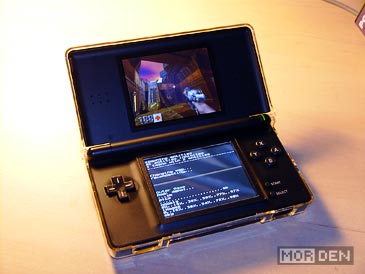
Well, that's about it, I think. I know there's a lot of bitching and whining in this entry, but if you're considering a purchase of EZ Flash V 3 in 1, don't be discouraged. Just know that it won't work out of the box, since it was designed to work with the slot one EZ Flash V, which supports the expansion from the firmware level. I did get the vibrations to work using ROM images of the games I legally own - The only thing I had to do, was to start the GBA ExpLoader and choose the vibration strength. There are about fifty Nintendo DS games that use the rumble feature, so it's nice to know I can feel those vibrations if I really want to - In other words, I won't completely neglect the rumble functionality. I will however continue using the EZ Flash IV when it comes to Game Boy Advance homebrew in general, but running Full Throttle, The Dig or Quake 2 wouldn't be possible without the RAM expansion. All in all, I think this little gadget was worth the money I paid for it. I will have some fun with it, and the best part is, since it's black and shaped like the original slot 2 cover, you won't even know it's there.
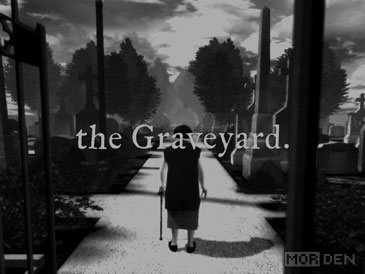
Only in the world of independent productions can we see games such as this one. In fact, after playing The Graveyard, I asked myself how much content does a game have to offer to be considered a game. Belgian developer duo Tale of Tales apparently think, that the feel and art direction are more important than gameplay, which in its turn makes The Graveyard into a nice experiment, but not necessarily a game in the usual sense of the word.
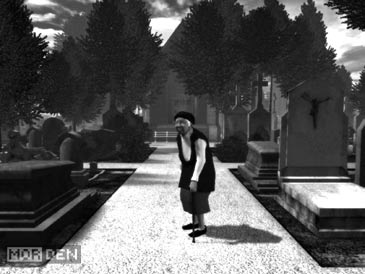
We take control of an old lady, who visits the local graveyard. The objective here is to get to the bench by the chapel. We can't go beyond the main path, and even if we stray from it, the camera won't follow our character, so there is virtually no exploration. After we get to the bench, we sit down and reminisce the years that have passed and the people we knew and lost - All that put into a Dutch song that luckily comes with subtitles.
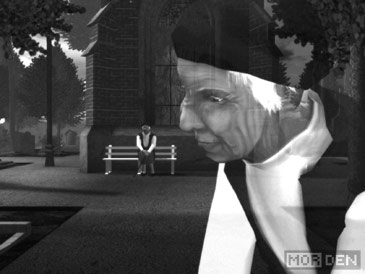
Simple as it may be, The Graveyard is a breath of fresh air in the world of shoot 'em ups, puzzlers and platformers. Believe it or not, the game is available in both demo and full versions. The full version will set us back $5 and is identical to the demo, except that each time you play the game, the old lady can die. That's pretty much all I can tell you about the full version, since I didn't feel like spending money just to see an old person die.
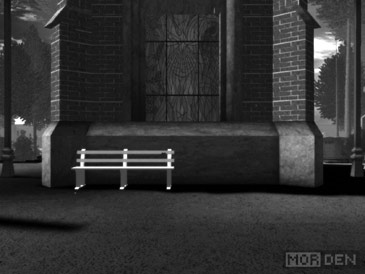
If you, however, would like to get the full featured version, go to the game's official webpage, choose either the Windows or Mac version and knock yourself out. If you like Tale of Tales' more artsy approach to game design, you could also check out The Path - a horror game like no other.
カレンダー
| 04 | 2024/05 | 06 |
| S | M | T | W | T | F | S |
|---|---|---|---|---|---|---|
| 1 | 2 | 3 | 4 | |||
| 5 | 6 | 7 | 8 | 9 | 10 | 11 |
| 12 | 13 | 14 | 15 | 16 | 17 | 18 |
| 19 | 20 | 21 | 22 | 23 | 24 | 25 |
| 26 | 27 | 28 | 29 | 30 | 31 |
カテゴリー
フリーエリア
最新CM
[02/23 jikoo]
[02/23 jikoo]
[02/21 sara]
[01/04 Inlagd]
[11/21 Inlagd]
最新記事
(01/31)
(01/27)
(01/04)
(11/14)
(11/12)
最新TB
プロフィール
HN:
No Name Ninja
性別:
非公開
ブログ内検索
最古記事
(12/17)
(12/19)
(12/23)
(12/25)
(03/30)
P R


